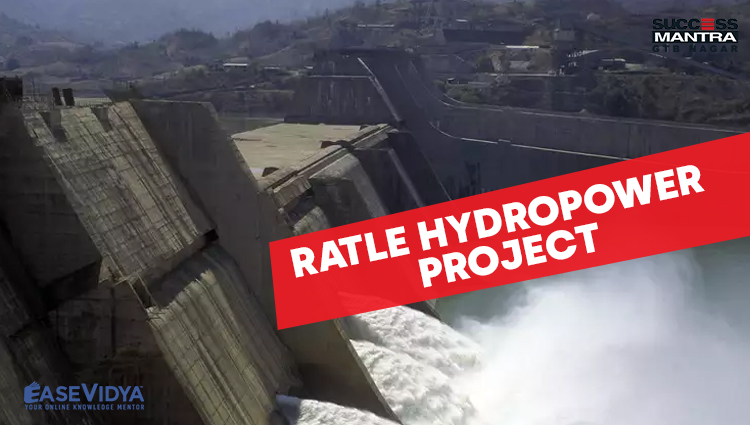
RATLE HYDROPOWER PROJECT
UNION CABINET APPROVED RATLE HYDROPOWER PROJECT

The Union Cabinet has given its approval for 850 MegaWatt (MW) Ratle hydropower project on Chenab River in Jammu and Kashmir. It is a run-of-the-river hydroelectric power station on the Chenab River, Kishtwar district of the Indian Union Territory of Jammu and Kashmir. It includes a 133 m tall gravity dam and two power stations adjacent to one another. The installed capacity of both power stations will be 850 MW. In June 2013, the then Indian Prime Minister laid the foundation stone for the dam. Pakistan has frequently alleged that it violates the Indus Water Treaty, 1960. It envisages an investment of about Rs. 5282 crore and the project shall be commissioned within a span of 60 months.
PAKISTAN'S OBJECTION & INDUS WATER TREATY
The Pakistan government in 2013 had objected to the construction of the dam, claiming that it was not in conformity with the Indus Water Treaty. In August 2017, the World Bank allowed India to construct the dam. Pakistan has approached the World Bank with fresh protests, but the Centre has now decided to go ahead with the construction. The Indus Waters Treaty was signed in 1960 after nine years of negotiations between India and Pakistan with the help of the World Bank, which is also a signatory. The Treaty provides India an absolute control of all the waters of Eastern Rivers while Pakistan shall receive for unrestricted use all those waters of the Western Rivers which India is under obligation to let flow beyond the permitted uses. The Ravi, the Beas and the Sutlej are together called as Eastern Rivers while the Chenab, the Jhelum and the Indus main are called as Western Rivers.
INDUS WATER TREATY B/W INDIA & PAKISTAN
• The Indus Waters Treaty is a water-distribution treaty between India and Pakistan, brokered by the World Bank, to use the water available in the Indus River and its tributaries. The Indus Waters Treaty (IWT) was signed in Karachi on 19 September 1960 by Indian Prime Minister Jawaharlal Nehru and Pakistani President Ayub Khan. Map of the Indus System of Rivers excluding its delta channels and tributaries draining in to Rann of Kutch.
• The Treaty gives control over the waters of the three "eastern rivers": the Beas, Ravi and Sutlej with a mean annual flow of 33 million acre-feet (MAF) to India, while control over the waters of the three "western rivers" the Indus, Chenab and Jhelum with a mean annual flow of 80 MAF to Pakistan. India was allocated about 20% of the total water carried by the Indus system while Pakistan was allocated the remainder.
• The treaty allows India to use the western river waters for limited irrigation use and unlimited non-consumptive use for such applications as power generation, navigation, floating of property, fish culture, etc. It lays down detailed regulations for India in building projects over the western rivers. The preamble of the treaty recognises the rights and obligations of each country in the optimum use of water from the Indus system in a spirit of goodwill, friendship and cooperation.
• This has not reduced the Pakistani fears that India could potentially create floods or droughts in Pakistan, especially in times of war. In 1948, the water rights of the river system were the focus of an Indo-Pakistani water dispute. Since the ratification of the treaty in 1960, India and Pakistan have not engaged in any water wars, despite engaging in several military conflicts. Most disagreements and disputes have been settled via legal procedures, provided for within the framework of the treaty. The Indus Waters Treaty is considered one of the most successful water sharing endeavours in the world today, even though analysts acknowledge the need to update certain technical specifications and expand the scope of the agreement to address climate change.
BENEFITS OF THE PROJECT
• Strategic: This comes in the backdrop of India’s plan to expedite strategically important hydropower projects in the union territory post its reorganization, as the government plans to fully utilize its share of water under the Indus Waters Treaty of 1960. The task is seen as strategically vital in the context of China developing the controversial China-Pakistan Economic Corridor (CPEC), part of its One Belt One Road (OBOR) infrastructure initiative.
• Socio-Economic Development: The construction activities of the Project will result in direct and indirect employment to around 4000 persons. Increase in disposable income will in turn lead to socio-economic development of the region.
• Power at Cheaper Rates: Union Territory of Jammu and Kashmir will be benefitted by getting free power worth Rs. 5289 crore.
• Surplus Power: The Power generated from the Project will help in providing balancing of Grid and will improve the power supply position. Grid balancing involves increasing existing power generating infrastructure to smooth out the supply of power.
• Government Revenue: Through levy of Water Usage Charges from Ratle Hydro Electric Project, during project life cycle of 40 years.
OTHER PROJECTS ON CHENAB BASIN:
• Kiru Hydro Electric (HE) Project: The Kiru HE Project of 624 MW installed capacity is proposed on river Chenab (Kishtwar district).
• Pakal Dul (Drangdhuran) Hydroelectric Project: It is a reservoir based scheme proposed on river Marusudar, the main right bank tributary of river Chenab in Kishtwar Tehsil of Doda District in Jammu & Kashmir.
• Dulhasti Power Station: It is run-of-the-river with an installed capacity of 390 MW to harness the hydropower potential of river Chenab (Kishtwar district).
• Salal Power Station: It is a run-of-the-river scheme with an installed capacity of 690 MW to harness the Hydropower potential of river Chenab. It is located in Reasi district of Jammu & Kashmir.
• Chenab River: It rises in the upper Himalayas in the Lahaul and Spiti district of Himachal Pradesh state. The river is formed by the confluence of two rivers, Chandra and Bhaga, at Tandi, 8 km southwest of Keylong, in the Lahaul and Spiti district. The Bhaga River originates from Surya taal lake, which is situated a few kilometers west of the Bara-lacha la pass in Himachal Pradesh. The Chandra River originates from glaciers east of the same pass (near Chandra Taal). It flows through the Jammu region of Jammu and Kashmir into the plains of Punjab, Pakistan, before flowing into the Indus River.













0 Comment